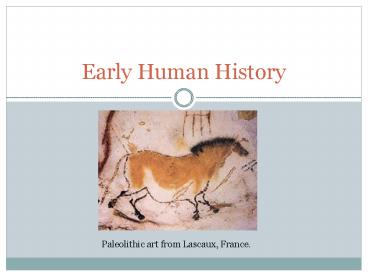Early Human History - PowerPoint PPT Presentation
Title:
Early Human History
Description:
Early Human History Paleolithic art from Lascaux, France. I. ... depended on hunting animals and collecting foods Humans evolved to what we are today: ... – PowerPoint PPT presentation
Number of Views:294
Avg rating:3.0/5.0
Title: Early Human History
1
Early Human History
Paleolithic art from Lascaux, France.
2
I. The Stone Age
- Stone Age split into three distinct periods
- Paleolithic (Old Stone) Age roughly 2 million
years ago until 12,000 B.C.E. - Mesolithic (Middle Stone) Age about 12,000 to
8,000 B.C.E. - Neolithic (New Stone) Age about 8,000 to 3,000
B.C.E. - Life during Paleolithic age
- Simple tool use (sticks, stones of varying shapes
and sizes) - Nomads highly mobile, moved from place to place
looking for food - Hunter-gatherers depended on hunting animals
and collecting foods - Humans evolved to what we are today Homo sapiens
sapiens - Originated about 240,000 years ago in Africa
3
I. continued
- Life in Paleolithic Age continued
- Population growth was slow hunter-gatherer way
of life cannot support large groups - Late Paleolithic development of culture
- A peoples unique way of life helps explain the
environment and rules for social behavior - Development of complex languages and speech
- Entire world is populated by end of Paleolithic
Age - Developments in the Mesolithic Age
- Last great Ice Age ends, living conditions
improve for most of the Northern Hemisphere - Human progress accelerates tools, weapons
become more sophisticated - Food storage, animal domestication (taming)
begins - Population growth accelerated
4
II. Neolithic Revolution
- Between 10,000 and 12,000 years ago, agriculture
(farming) began - This is called the Neolithic (or Agricultural)
Revolution - Took thousands of years to spread from Middle
East (Fertile Crescent) to rest of world - Many groups began by practicing an early
agriculture technique called slash-and-burn
farming - Cut and burned vegetation to clear a field
allowed to grow back after a year or two, once
farmers have moved on - Further domestication of animals horses, dogs,
goats, pigs, sheep, camels
5
II. Continued
- Neolithic Revolution paves way for permanent
settlements - Agriculture allowed larger groups to live in one
place - Catal Huyuk
- A Neolithic Age village, founded about 7,000
B.C.E. in modern-day Turkey - Population was in the thousands
- Specialized workers and cultural life flourished
- Drawbacks natural disasters, diseases, warfare
were common problems or people live closely
together - Neolithic Revolution comic
6
III. Civilization
- Permanent settlements, like Catal Huyuk, led to
emergence of civilization - Societies that rely on agriculture, produce food
surpluses - Have formal political organization
- Characterized by groups of non-farming elites,
merchant and manufacturing groups, specialized
workers - Development of writing
- Essential to civilization for communication,
record keeping, establishment of law and order - Cuneiform first system of writing, emerged in
Middle East around 3500 B.C.E.
7
IV. End of Stone Age
- Bronze Age
- Emergence of civilizations also brought about the
end of the Stone Age - Bronze Age began around 3000 B.C.E. with the
widespread use of bronze (type of metal) tools
8
Key Vocabulary Chapter 1 (Part 1)
- Paleolithic (Old Stone) Age
- Homo sapiens sapiens
- Neolithic (New Stone) Age
- Neolithic Revolution
- Hunting and gathering
- Bronze Age
- Slash and burn agriculture
- Bands
- Catal Huyuk
- Civilization
- Cuneiform
- Nomads































